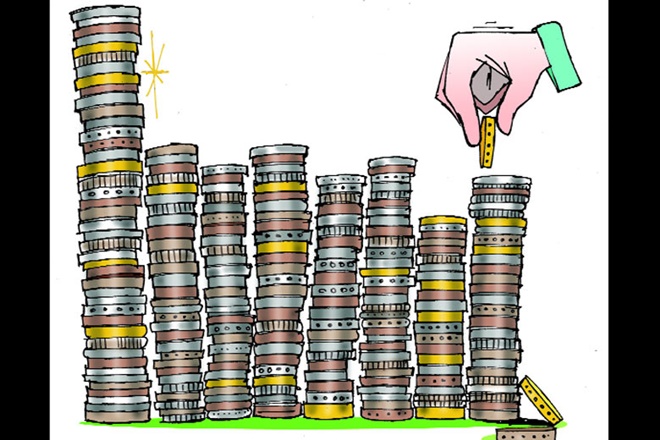Subdued animal spirit: Private investment slumbers as uncertainties fester

The recent GDP revisions for 2016-17 and 2017-18 would have surprised even an ardent supporter/admirer of the Central Statistical Office (CSO). Unwittingly though, it has made the lives of doubters like this author a lot easier! For, those who repeatedly pointed to the dissonance between these GDP estimates and other lead indicators can now assert with reasonable certainty that the Indian economy has two parallel narratives: One that paints a fairly rosy picture based upon official statistics,describing the country as the “fastest growing large economy in the world”, and another, quite the opposite, of one bogged down by subdued economic activity that has failed to ignite the animal spirit of investment.

Until the revised GDP estimates came out on January 31, the general perception was of an economy driven largely by consumption. But, suddenly, the storyline changed. Investment, it seemed, was actually upward bound and has been so since 2013-14. Gross fixed capital formation (GFCF) grew strongly at 8.3% and 9.3% in FY17 and FY18 respectively, and is projected to accelerate at 12.2% in FY19. But if you look for supporting evidence, there is hardly anything convincing!
Many point to the recent credit pick-up that supports official data. But if we look at sector-wise details, it is still a consumption-side growth story. Credit growth to industry remains very weak. In fact, real or inflation-adjusted credit to industry contracted an average -1.7% each month in April-December 2018. This turned positive only in the last quarter; then, too, a 2.3% (y-o-y) growth in December 2018 was lower than seen four years ago (2.9% in December 2014). Although one can draw comfort from the fact that this is half the average monthly decline observed during the previous year (April 2017-March 2018), in which credit to all industries shrank -3.6% in real terms, in 2016-17, the fall was even steeper, averaging -6.1% each month.
Another piece of evidence depicts an even bleaker picture. CMIE’s project-tracking database shows new project announcements at their lowest level since mid-2004; stalled projects reached a near record. Such announcements have steadily trended downhill from a December 2014 peak; in annual and sequential terms, these were 48% lower in the December 2018 quarter.
What is striking is the remarkable parallel with the downward trend in new project announcements and accumulating stalled projects, captured in the same data not long back. Recall the 2011-2013 period, when GDP growth slowed sharply, underpinned by a precipitous fall in private investment that was driven by uncertainties attributed to policy paralysis. That period was defined by poor governance, strict environmental regulations, difficult land acquisition, and retrospective taxation, all of which dented business confidence. In fact, applying the Bloom-Baker-Davis policy uncertainty index, the IMF argued that heightened policy uncertainty had a particularly pronounced link with the decline in new investments and increasing share of postponed or cancelled investments.
The new government that came in May 2014 appeared to have addressed many of these issues, achieved macroeconomic stability and introduced some key structural reforms to foster growth. And yet, the animal spirit that urges businessmen to act has not sprung alive. This is not only worrisome but also raises some concerns. For example, if the world economy slips into another round of recession, the Indian economy runs the risk of getting trapped into a prolonged investment drought! It is seven-to-eight years now that investment has not returned to life.
During UPA-II, businessmen were forthright in attributing this to the widespread governance deficit and corruption, but in the current NDA regime, hardly anyone has spoken! On the face of it, this silence is interpreted as ‘all is well’. But the lack of interest in pushing investment points to something underneath is holding them back. That something is possibly ‘hidden uncertainties’—related to sudden disruptions to an existing business ecosystem, dampening risk appetite and making businesses unsure if they have the right platform to seek redressal!
We point out several such ‘hidden uncertainties’ subduing this animal spirit. In the first round, uncertainties arose from demonetisation and a poorly-implemented GST. Both upset the established viability and future prospects of many existing businesses, besides behavioural effects related to cash transactions, disclosures, and all such. In the next round, policy zig-zags and a lack of action in some spheres have aggravated and/or induced further uncertainties. For example, the festering NPAs and lack of clarity about the direction of public banking has been exceptionally stretched and none too close to a foreseeable end. The fate of an estimated Rs 3.8 trillion invested in power projects and numerous others stuck at various stages of resolution hangs in the air. A general drift of economic policies towards excessive state intervention and lesser market-orientation has made businesses very cautious. The tax-terrorism that is being spoken of, and an approach that views every aspect of business from the sole standpoint of taxation, tax-evasion, money-laundering, fixing promoters/directors’ liabilities, etc., has created a different set of uncertainties in the business environment.
These run parallel to the arrival of a new bankruptcy law that has jolted an established equilibrium; on top of this, a constant stream of interpretations and amendments to this law cumulates uncertainty about future directions and prospects. The enormous scale of wealth destruction, as assets go up for sale at severe discounts—within the confines of this law and outside its boundaries—is something that is bound to make businessmen think a hundred times over before committing fresh capital.
Frequent changes in taxation, rules and the sudden introduction of new taxes (like the GST, ‘angel tax’ and start-up norms, e-commerce, etc.) add to the long list. All these sum up to an increasing difficulty of doing business despite the rise in EoDB rankings. Finally, a rising incidence of fresh business failures and financial stress, such as those in the telecom, aviation, infrastructure, and, of late, the shadow banking segments, with cascading effects in related parts, also escalates doubts about future business prospects.
One must note that positive reforms like GST and the IBC law also induce uncertainty because these affect future project viabilities leading to a wait-and-watch attitude. Others, like demonetisation, tax coercion, state intrusion, and inertia in addressing banking sector, regulatory and NPA issues are downright negative. But why do we call this a ‘hidden’ uncertainty? We call it ‘hidden’ because it is submerged under the bright sunshine of strong GDP growth—growth that is averaging 7.7% in the past four years if you will; an exceptional 8% and 8.2% in FY16 and FY17. This positive growth narrative submerges the doubts lurking beneath and prevents their eruption to the surface. However, it manifests in the absence of animal spirit—the confidence that drives businessmen to invest.
But for the two conflicting yet parallel growth stories observed from official GDP statistics and other lead indicators, the zest to invest is no better or much the same as in 2012-13. The statistically visible investment-growth slump at that time had haunted the UPA government. The question is, if a different set of concerns this time around will simply wilt under the strong sunshine of an optimistic growth story.
[“source=financialexpress”]




